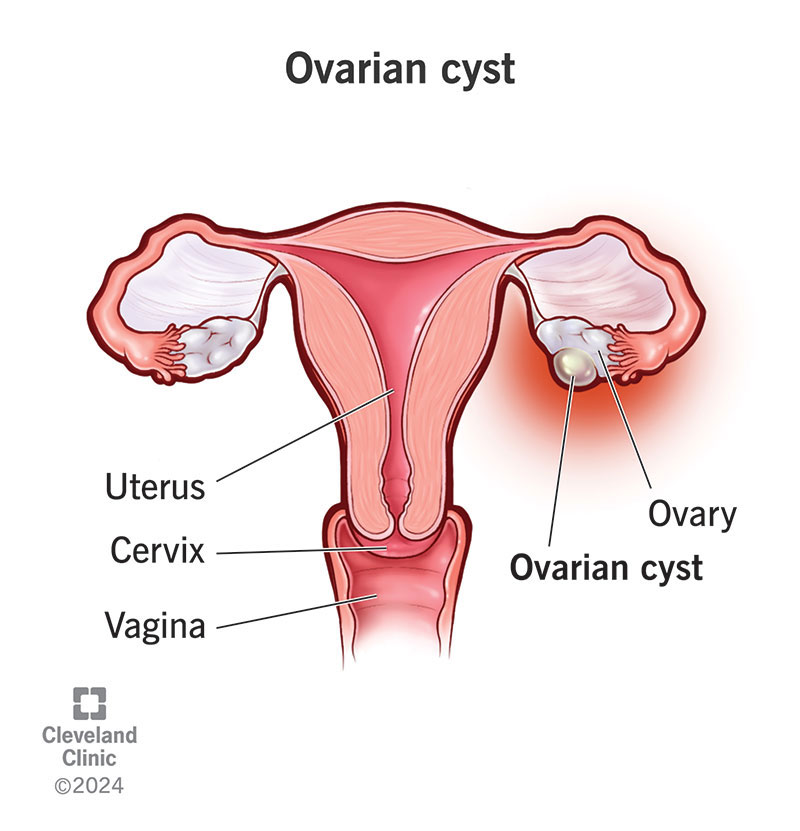Ovarian Cyst
An ovarian cyst is a fluid-filled or semisolid sac that can develop inside on top of or inside both of your ovaries.

Description:
The tiny glands in your pelvis, called ovaries, are responsible for producing hormones like progesterone and estrogen as well as storing egg cells. Every ovary resembles an almond in both size and shape. Eggs grow and develop inside the ovaries. Monthly cycles of egg release occur during the childbearing years. Ovarian cysts come in a variety of forms, the majority of which are benign (meaning they don't hurt) and harmless. Ovarian cysts typically don't show any symptoms. Unless your doctor discovers one during a standard pelvic exam or imaging technique, you probably won't be aware that you have one. Ovarian cysts can occasionally result in difficulties. Ovarian cysts come in a variety of forms, the majority of which are benign (meaning they don't hurt) and harmless. Ovarian cysts typically don't show any symptoms. Unless your doctor discovers one during a standard pelvic exam or imaging technique, you probably won't be aware that you have one.Ovarian cysts can occasionally result in difficulties. They are different types: i) Functional cysts : The most prevalent kind of ovarian cysts are functional cysts that are unrelated to any disease. Ovulation or the release of an egg from the ovary is the cause of them. These cysts may indicate that your ovaries are doing their job properly. Without special care, functional cysts usually decrease over time—typically within 60 days. ii)Follicular cysts: Each month, as part of your menstrual cycle, a little sac called a follicle in your ovary releases an egg. When a follicle fails to release an egg, a follicular cyst develops. Rather, the follicle enlarges and is filled with fluid. iii)Corpus luteum cysts: The corpus luteum is a collection of cells that produces hormones and is formed by the follicle after it releases an egg. When fluid builds up in the corpus luteum and causes it to enlarge, a cyst is created. Simple cysts are another term for functioning cysts. iv) Other cysts: Some cyst types are unrelated to menstrual cycles and include: v) Dermoid cyst: This cyst, also known as a teratoma, develops from ovarian germ cells, which are reproductive cells that produce eggs. Tissue from the skin hair or teeth may be present in the cyst. Rarely is this kind of cyst cancerous. vi) Cystadenoma: The cells that form this kind of cyst are found on the ovary's surface. There's a chance that the cyst is packed with mucus or water. Large cystadenoma growth is possible. vii) Endometrioma: A disorder known as endometriosis causes cells that line the inside of the uterus to proliferate outside of it. A cyst may develop from tissue that has attached itself to the ovary. We refer to this as an endometrioma. Large dermoid cysts and cystadenomas have the potential to shift the ovary out of place. This raises the possibility of ovarian torsion a painful twisting of the ovary. Blood flow to the ovary may be decreased or stopped by ovarian torsion.
Cause:
The primary cause of ovarian cysts is ovulation. Additional reasons consist of: •Cell reproduction is abnormal. Atypical cell reproduction can lead to the formation of cysts such as cystadenomas and dermoids. •Endometriosis. In the later stages of endometriosis, these cysts frequently develop on the ovary. •Pelvic inflammatory disease (PID). Cysts can develop in your ovaries as a result of severe pelvic infections.
Symptom:
Ovarian cysts frequently show no symptoms at all. However, if the cyst gets bigger, symptoms can show up. Among the symptoms could be: •Bloating or swelling in the abdomen •Painful bowel motions •Pelvic pain before or during the menstrual cycle •Painful intercourse •Pain in lower back or thighs •Breast tenderness •Vomiting and nausea Severe symptoms could be the result of an ovarian torsion or a burst cyst. They consist of: •Fever •Faintness or dizziness •A cute or intense pelvic pain •Fast breathing Although these problems are uncommon, delaying treatment can have negative effects.
Ayurveda Treartments:
Snehanam Swedanam Lepanam Virechanam Matra Vasti Uttravasti Pichu Kashaya vasti
Naturopathy Treartments:
Hip bath Immersion bath Arm & foot bath Enema Steam bath Mud therap Acupuncture Manipulative therapy Diet therapy Clinical yoga Kriyas
